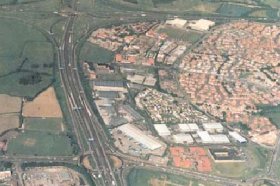
 Bristol
is the eighth largest city in the country (metropolitan population c.
900,000), and freestanding in functional terms. In recent years, the effects
of deregulation, competitive attempts to attract and create new enterprise
and greater responsive-ness to consumer preferences have all led to a
weakening of the grip of regional and local planners upon urban development.
In the country, despite changing govern-ment targets for the re-use of
'brownfields' land, this has frequently led to urban sprawl. During the
1960s and 1970s the locus of manufacturing activity shifted to suburban
sites, and a growing population was accommodated in suburban develop-ments.
During the last 20 years, retailing activity has been allowed to follow
these pervious movements, with the result that the country has one of
the highest inci-dences of out-of-centre retailing in the EU. During the
late 1990s these centrifugal tendencies, coupled with a laissez-faire
approach to urban planning, led to the development of a large number of
peripheral out-of-centre shopping and office centres and parks, similar
in function (if not always in size) to the edge cities of the USA.
Bristol
is the eighth largest city in the country (metropolitan population c.
900,000), and freestanding in functional terms. In recent years, the effects
of deregulation, competitive attempts to attract and create new enterprise
and greater responsive-ness to consumer preferences have all led to a
weakening of the grip of regional and local planners upon urban development.
In the country, despite changing govern-ment targets for the re-use of
'brownfields' land, this has frequently led to urban sprawl. During the
1960s and 1970s the locus of manufacturing activity shifted to suburban
sites, and a growing population was accommodated in suburban develop-ments.
During the last 20 years, retailing activity has been allowed to follow
these pervious movements, with the result that the country has one of
the highest inci-dences of out-of-centre retailing in the EU. During the
late 1990s these centrifugal tendencies, coupled with a laissez-faire
approach to urban planning, led to the development of a large number of
peripheral out-of-centre shopping and office centres and parks, similar
in function (if not always in size) to the edge cities of the USA.
![]()
The next pages illustrate our preliminary analysis of sprawl in Bristol.
Full documentation of this research is available as
Deliverable 3. A comparative analysis
of sprawl in all six cities has also been carried out.
